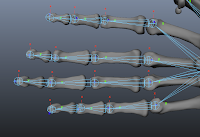So, it seems that I am destined to be rigging hands for years to come. It's been quite a while since
first rigged my hand for the
spider crawl, which actually turned out pretty fun.
That was one of the first tests I did using that IK/FK rig for the hand. A simple walk cycle - I can see now how certain fingers slide inappropriately and there could be a lot of refinement. And I beg your indulgence in this video - a short clip of the hand from the animatic I made for a school project, back in the day. But a good example of the animation I was doing then.
I'm not even going to go into what I would change - but I would love to revisit this animation. And I may do so eventually. It was a fun concept.
However, this is one example of what kind of animations can be produced with a semi-decent IK rig. A more generalized type of motion, very fluid, not very precise, but more 'movie-like.'
I consider this to be a 4 (on a scale of 1 to 5) for complexity. I didn't include a way to manipulate individual carpal bones, like you can do with this type of rig.
 |
| Hand rig with carpal bone manipulation |
Most rigs don't need carpal bone changes, as they actually change very, very little. I also realized that most rigs aren't using actual bones either, but pretty much all of mine do. A 'hazard' of being a medical illustrator.
I have done some animations that actually show the changes in carpal bones during tensing and relaxing of specific motions. However, those were all FK only rigs, as I needed to very specifically place and animate all of the bones (based upon fluoroscopic videos and segmented bones from CT scans from the tensed and relaxed positions). This was another early rig, and I can think of better ways to do it now, but it served it's purpose at the time.
I just finished another rig, one for an arm, including the hand. We are testing out a new, innovative type of motion capture (that I can't actually say much about now...) and we needed a basic rig for said testing.
So, I have a FK rig for the shoulder, elbow, wrist, and fingers here. I used to bind anatomical bones to rigs using the rigid bind method, as they are rigid bodies, but that actually really limits you on later editing. So, I now bind using the smooth bind, but I limit the influences to 1 and bind to selected joints only. This helps me during the process of editing the rig as necessary (and makes for very pretty colors).
The hand itself is a fairly simple rig as well. The thumb has a metacarpal joint, but the fingers do not. The finger metacarpals are pretty stationary (with some exceptions, but not an appreciable amount for this type of rig). The fingers and thumb can bend at every joint, and the wrist also has basic movement as well.
I'm not entirely happy with the way the wrist moves, as there is sliding motions involved in true wrist movement, and my rig just has the rotation involved now. I'm thinking there might be some MEL scripting that I can incorporate to automatically slide the joint as it rotates, but I haven't worked it out yet. I'm letting it percolate in the back of my head right now.
As you can see here, the joints were improperly rotated at first. This caused the fingers to deviate improperly when formed into a basic fist (as well as other movements).
I generally use the finger curl/fist movement to initially test a rig as it shows big problems right away without a lot of testing needed.
I popped back into the component editing and straightened out my joints further.
And now you can see that the fist is correct. This is the extent of this rig, as it is only being used to test another system.
I've certainly learned a great deal since that initial hand animation. I use hand rigs quite often at Stanford, mostly just to position different types of anatomy, especially the bony structures. I don't use the IK-FK method often, as I usually need to position bones quick and dirty like.
My next greatest challenge (probably a 12 on the scale) is to make a rig that can handle all of the soft tissue elements (muscles, ligaments, arteries, and nerves) as well as the bones. That's... going to take some thinking.

































